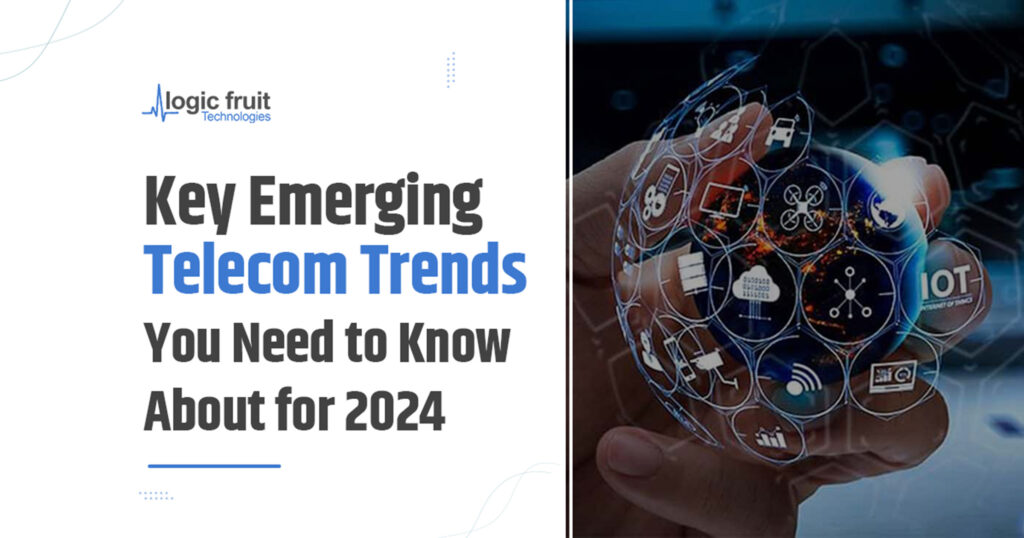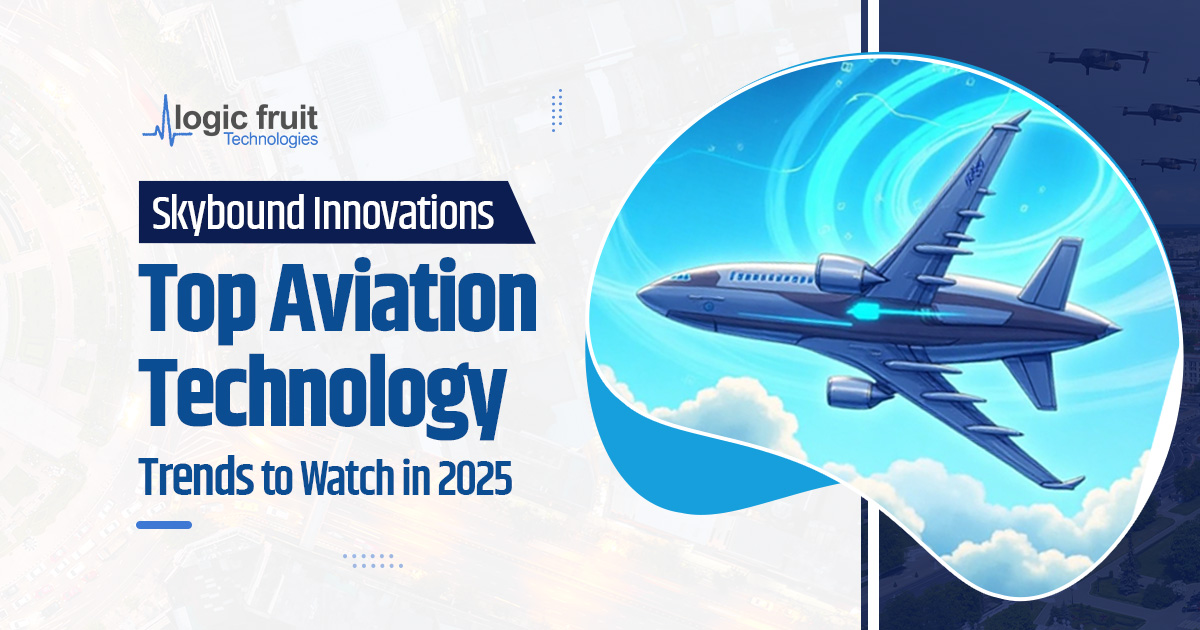Telecom Trends:- In today’s business world, telecommunication is one of the most crucial communication types.
The most widely used Telecom service in the modern world is UCaaS, or Unified Communications as a Service.
The evolution of telecom has been occurring at a remarkably rapid rate. Civilizations flourished around the newest technological developments that enabled contact between distant parties.
Prior to achieving the current level of worldwide connectivity, wireless communications evolved through several stages.
According to the Investindia report, As of April 2024, India’s telecom industry ranked second globally in terms of total users (wireless plus wireline), with 1.091 billion.
India’s teledensity as a whole is 85.76%; of this, the mainly unexplored rural market’s teledensity is 59.44%, while the urban market’s teledensity is 133.42%.
The telecoms sector continues to lead innovation, boosting global connectivity and communication.
The telecom sector has a lot of opportunities this year, from the exciting introduction of 5G to the smooth fusion of AI and IoT.
In this blog, we’ll examine the top 10 industry trends and offer forecasts for upcoming innovations that may enhance services, increase connectivity, and provide us all with more meaningful experiences.
Join us as we investigate the revolutionary route that 2024 will bring for telecom.

Evolution of Telecommunications
The first mechanical communications device, the electrical telegraph, was created in the 1830s, sparking the start of the Telecom sector. Days of communication were cut down to hours.
For the purpose of relaying messages in Morse code, telegraph networks required a substantial infrastructure in addition to hundreds of highly skilled operators.
The telecoms sector expanded with new inventions over time.
The capacity to communicate over great distances was increased by the development of new Telecom networks made possible by each of the following inventions:
- Telegraphs: They were created in the 1830s and made it possible for written messages to be sent swiftly over land.
- Telephones: They were developed in 1876 and made it possible to transmit human speech, which eliminated the need for Morse code operators.
- Radio and television: Eliminated the need for wired networks by enabling transmission over the airways.
- Cellular and satellite networks: decreased dependency on fixed phone networks.
- Computers and the internet: facilitated the automatic transfer of information far more quickly than was feasible through text or speech from a human.
Since its invention, Telecom technology has advanced rapidly, completely changing how people engage and communicate on a global scale.
The trip started with the introduction of analog phone calls with 1G, the initial generation of mobile networks.
Text messaging, internet browsing, and multimedia services were made possible by the digitization brought about by later generations 2G, 3G, and 4G in particular.
Though 5G promised previously unheard-of speeds, extremely low latency, and widespread connectivity, it was still the biggest leap forward.
Telecommunication technology is still evolving even while everyone waits for the introduction of 6G, which is expected to surpass the capabilities of its predecessor.
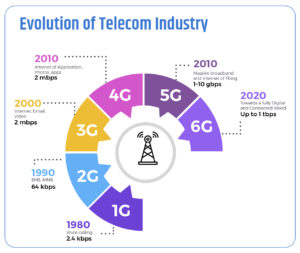 Market growth of the Telecom industry
Market growth of the Telecom industry
According to Skyquest, The size of the global telecommunications market was estimated at USD 1700.2 billion in 2019 and is expected to increase at a compound annual growth rate (CAGR) of 6.2% from USD 1805.61 billion in 2023 to USD 3102.74 billion by 2031.
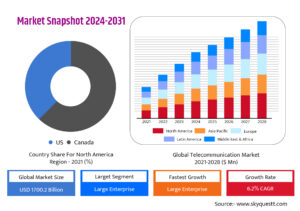
A variety of communication tools are used in the telecommunications sector.
The market opportunities for telecommunication are being pushed by the increase in communications demand around the world.
By component, enterprise, industry, and geography, the global telecommunication market is divided into segments.
The Global Telecommunication Market is divided into three segments: Services, Software, and Hardware, based on the Components.
The Global Telecommunication Market is divided into two segments: SMEs and Large, based on Enterprise.
The Telecom Market is divided into E-commerce retail, media & entertainment, IT & telecom, healthcare, transportation & logistics, and other sectors based on industry.
It is divided into five regions: North America, Europe, Asia-Pacific, South America, and the Middle East and Africa.
Top 10 trends of the Telecom industry in 2024
Internet of Things (IoT)
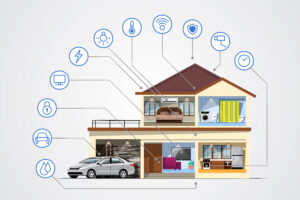
IoT devices and sensors are having a big impact on the technological economy, improving management overall, increasing business profitability, and improving people’s quality of life.
With its capacity to cause significant disruptions in the environment, the Internet of Things (IoT) is one of the most popular innovations in the telecommunications sector.
LoRaWAN and NB-IoT are two examples of Low Power Wide Area Network (LPWAN) technologies that are essential to the widespread adoption of IoT applications.
IoT also provides cost-saving advantages for governments looking to cut back on IT-related spending.
Innovative management opportunities are being made possible by the interconnectedness of devices, sensors, infrastructure, and computing components.
Edge Computing
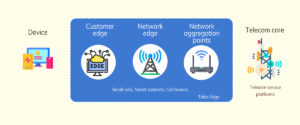
In the telecom industry, edge computing refers to relocating data processing and storage closer to the data source rather than depending on a centralized, distant cloud.
By integrating devices with edge data centers, this method lowers latency, improves bandwidth, simplifies maintenance, and makes it possible for businesses to increase their computing capacity more economically.
High-speed connectivity and reduced latency are essential for modern applications like virtual reality and cloud gaming.
Edge computing lowers the need for data interchange while greatly improving the end-user experience.
The field of edge computing has a lot of potential for the future of communications.
Telecom companies have the chance to increase revenue by utilizing their infrastructure and experience to advance up the value chain and become a part of the computing and networking infrastructure of the future.
5G Networks & Technology

In 2024, 5G will lead the telecom sector in trends. It could result in significant societal and economic benefits.
The next big development in Telecom networks and gadgets is 5G technology.
It is notably faster than earlier cellular broadband standards and, more importantly, has much lower latency.
For applications like streaming VR content and cloud gaming, low latency is extremely important.
Massive machine-type communications (mMTC), which 5G brings to the telecom sector, make it easier to build dense Internet of Things (IoT) networks that extend from smart homes to Industrial IoT (IIoT).
According to the Communication Today report, The 5G technology market is anticipated to increase significantly; by 2024, operators are predicted to earn USD 400 billion in service revenue from 5G networks. This indicates a 32% annual growth rate from 2023, underscoring the substantial influence of 5G on the telecom industry.
Artificial intelligence

Global business continues to be impacted by artificial intelligence (AI).
Telecom service providers are employing clever automation and artificial intelligence proactively to enhance customer experiences and boost operational efficiency.
Machine learning (ML) technologies are also being utilized to improve overall service quality, expedite decision-making, and automate processes.
Telecom AI solutions will keep getting better in 2024, automating more network processes and handling anything from service provisioning to site setup.
According to Precedence research, The size of the worldwide AI in Telecom market was estimated at USD 1.34 billion in 2023 and is expected to increase at a compound annual growth rate (CAGR) of 41.40% from 2024 to 2033, reaching approximately USD 42.66 billion.
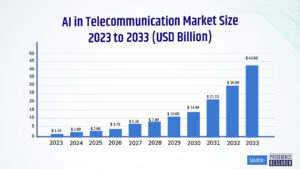
AI-powered virtual assistants in telecom manage client inquiries, customize assistance, and expedite communications, all while cutting expenses and raising client happiness.
They guarantee continuous assistance 24/7, which enhances telecom users’ accessibility and reactivity.
High-Resolution Content

The widespread adoption of smartphones and dependable internet connections has led to an increase in the consumption of high-quality media, including images, movies, and music.
The issue is that large file sizes are usually associated with HD material.
Telecom technology assists organizations in adjusting to this more influential media stream.
This covers cloud-based gaming as well as new media formats including virtual, augmented, and mixed reality (VR/AR/MR) experiences.
For these new multimedia forms to be engaging, they also require low latency and high-speed data transfer.
As a result, businesses are being prompted to concentrate on developing robust, high-capacity communications networks.
Network Slicing
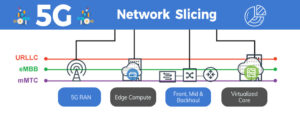
A telecom arrangement known as “network slicing” enables the creation of several separate, virtualized networks on top of a single physical infrastructure.
The precise requirements of the application, use case, or client might determine how each “slice” or section of the network is allotted.
With network slicing, the telecom sector is transforming several virtual networks that may be created on a single physical infrastructure.
With the use of this technology, telecom operators can improve service delivery and optimize resource usage by customizing network performance to match unique requirements.
Network slicing, which offers previously unheard-of flexibility and efficiency, is expected to play a crucial role in the future of telecoms as 5G technology develops.
Ultra-low latency (URLLC) and fast data speeds are necessary for various 5G use cases, such as driverless automobiles, while great dependability and security are required for services like smart parking meters.
With 5G network slicing, various varied services are supported and resources are reallocated as needed from one virtual network slice to another, rendering the outdated one-size-fits-all method of service delivery.
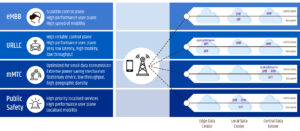
Open RAN

A particular kind of mobile network called a radio access network (RAN) connects end-user devices like smartphones to the cloud.
To do this, radio waves are used to carry data from these devices to RAN transceivers, and from there to the core network, which is connected to the global internet.
As additional edge and 5G use cases for telco customers appear, RANs, which are crucial connection sites for telecom network operators, represent significant total network expenses.
They undertake complex and expensive processing and are currently seeing a sharp increase in demand.
Telecom may be able to have more flexibility in their partnerships with OEMs thanks to new RAN techniques.
Additionally, they can reduce the requirement for tangible assets like cables, towers, and antennas.
This may lead to reduced startup and ongoing expenses, expedited rollout of new network services, and heightened competition among vendors.
These novel techniques are included in the “xRAN” category. One of its features is open RAN (ORAN), which when developed would enable smooth hardware and software compatibility across different suppliers.
Telecom Cybersecurity

The term “telecom cybersecurity” describes the strategies and tools used to guard against unwanted access, malicious attacks, and system damage.
Since it deals with safeguarding data traveling across Telecom networks, mobile devices, and other communication infrastructures, this area of cybersecurity is vital.
The emergence of 5G technology has added complexity to the Telecom industry, necessitating the need of strong cybersecurity measures.
Telecom cybersecurity includes the protection of network equipment, servers, data centers, and other infrastructure, as well as software used for data management and transmission.
It also emphasizes safeguarding the copious volumes of sensitive data that are transferred across these networks, such as private user information, corporate correspondence, and government data.
According to Fortune Business Insights, With a forecasted value of USD 172.32 billion in 2023 and USD 424.97 billion in 2030, the worldwide cybersecurity industry is expected to grow at a compound annual growth rate (CAGR) of 13.8% between 2023 and 2030.
Cloud Computing

The extensive usage of IoT devices and the implementation of sophisticated machine-learning algorithms have created a significant need for processing capacity.
This demand has become a critical factor for the telecom sector, pushing it to adopt innovative solutions.
There are several benefits to moving data, apps, and key business components to cloud computing environments.
Network function virtualization, cloud-native technology, and software-defined networking come together to produce a distributed computing network that is made up of cloud-based telephony services.
Because the network and its associated computing resources are dispersed over multiple websites and clouds, effective automation and orchestration procedures are required.
According to Precedence Research, The global telecom cloud market size was estimated at US$ 35 billion in 2022 and it is expected to surpass around US$ 131.47 billion by 2032 with a significant CAGR of 14.2% from 2023 to 2032.
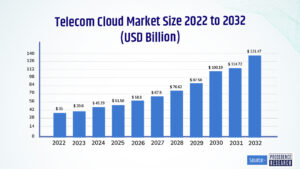
Connectivity Technologies

This capability is used in the Telecom industry to connect and communicate with other devices and/or systems.
In order to exchange data and create a direct connection through the use of digital information.
The field of connectivity technologies, which includes both wired and wireless communication techniques, is always evolving.
The development of communication technology is critical in today’s IT environment because of the increasing amounts of data, the spread of IoT devices, and the expanding number of internet users.
Conclusion
The telecom sector encompasses a wide-ranging, complex web of infrastructure, companies, and technologies that provide voice, data, and networking services.
It is the foundation of the digital age, supporting everything from conventional phone service to state-of-the-art fiber optic networks and mobile broadband.
The main tech-telecom trends covered in this blog post explain how telecom operations can be changed to foster innovation in operations and business models.
In essence, these new developments in the telecom sector demonstrate the industry’s dedication to adapting, innovating, and satisfying the ever-changing demands of its global clientele.


